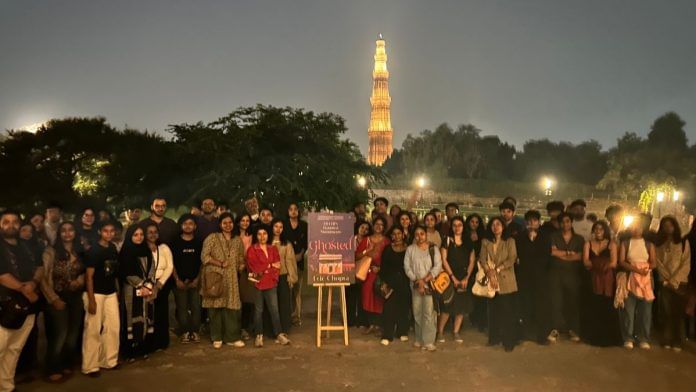New Delhi: As the sun set on a foggy Halloween evening, a group of Delhi citizens gathered at the Jamali Kamali tomb in Mehrauli to answer the question, What makes Delhi haunted?
A ‘Halloween Heritage Walk’ was organised by the city-based history group itihāsology on 31 October, but little did the 100-odd attendees know that Delhi’s spooky history awaited them in more than one way.
“Jamali was a quintessential Dilliwala—you would have seen him getting a Gymkhana membership if he were alive now,” Eric Chopra, founder of itihāsology and history enthusiast, told the crowd. “So it was only befitting to announce the launch of my new book here!”
In front of the 16th-century tomb and mosque, Chopra unveiled the cover of his new book, Ghosted: Delhi’s Haunted Monuments. Since the book traces the history of the city through five ‘haunted’ monuments, it felt apt to inaugurate the cover on the spooky occasion of Halloween, said Chopra.
Just like the heritage walk, Chopra’s book also begins with Jamali Kamali, which is a mosque and tomb complex built by Sufi poet Sheikh Jamali Kamboh, colloquially called Jamali. While there are many references to him as a poet in the courts of Sikander Lodi, Ibrahim Lodi, Babur, and even Humayun, his tomb partner Kamali remains a mystery. According to Chopra, the haunting begins here.

“There are various stories about who Kamali is. The most common one is that Jamali-Kamali is named after two djinn, Jamaluddin and Kamaluddin,” he explained to the rapt audience. “It is said that the djinn still live here, in the little alcoves and jharokas built into the structure.”
Looking toward the mosque, Chopra pointed out the window-shaped openings where the djinn are said to live. The history enthusiast was particular to point out that these djinn aren’t like the Genie from Aladdin. They’re ‘spirits made of smokeless fire’ that can be good or malevolent.
The Jamali Kamali djinn, he said, are malevolent and continue to reside in the tomb. It is also the reason why the place is considered haunted—the djinn refuse to leave the monument, which is why the mosque remains empty, with no prayers offered there. Each time Chopra visits the monument, he said, he gets lucid dreams afterward.
But there is another story behind the monument’s name, which Chopra finds more befitting. In this version, Kamali isn’t a random person or a mere follower of Jamali’s. Instead, he is Jamali’s lover. This version has a possible explanation for why the men are buried together, side-by-side.
“It is not a very popular theory, because I guess people are willing to believe more in ghosts than they are in love,” said Chopra. “But for all its mystery, enigma, and strands of ambiguity, the place and its story have managed to carve a space for Delhi’s queer community.”
Also read: No mosquito nets, no medicine—Teltumbde recounts life in prison in ‘The Cell and the Soul’
The ghosts and people of Delhi
More than 1,000 people signed up for Chopra’s walk, which promised a one-of-a-kind insight into the haunted history of this ancient city. While only 100 were allowed, many of them were long-time followers of itihāsology, which has been curating walks, stories, and social media content about Indian history since 2019.
“I wanted to start my walk and introduce my book in Mehrauli because as Delhi’s oldest capital city, it only seemed right,” said Chopra. “And I knew before any official releases or launches, I wanted my book to first be announced to the people who made it possible.”
The crowd was largely college-going students and young professionals, but there were also some new entrants drawn in by their passion for all things history and horror.
“I just shifted to Delhi from Jaipur, and I wanted to know more about this city and its stories,” said Kanu, a counsellor working in the city. “This was one of the best introductions I could have had to Delhi, because I get to see it from the lens of people’s history.”
As the walk weaved through Jamali Kamali toward the Quli Khan Tomb in the Mehrauli Archaeological Park, Chopra weaved together stories from the Delhi Sultanate era, the early Mughal era, and the British era. Quli Khan Tomb, for instance, was a 17th-century tomb built for Akbar’s wet-nurse Maham-Anga’s son Quli Khan. But in the 19th century, British Governor General Thomas Metcalf turned the tomb into his own personal residence.
A student of St Stephen’s College, Chopra began itihāsology in 2019, when he had just left high school. He wanted to share his passion for history in bite-sized chunks for common people and make historical facts and nuggets accessible. The walks, museum tours, and events he organised with his small team at itihāsology are what finally culminated in his new book, being published by Speaking Tiger.
Ending the walk at the Quli Khan Tomb, with the Qutub Minar gently illuminating the landscape behind him, Chopra thanked the audience for joining him on the journey.
“In writing and researching my first book, I’ve had the privilege of meeting some amazing folks, and also finding out that history is, at the end of the day, made up of people like you and me,” said Chopra. “In a way, looking for the ghosts of Delhi led me to discover the people of Delhi.”
(Edited by Prasanna Bachchhav)






